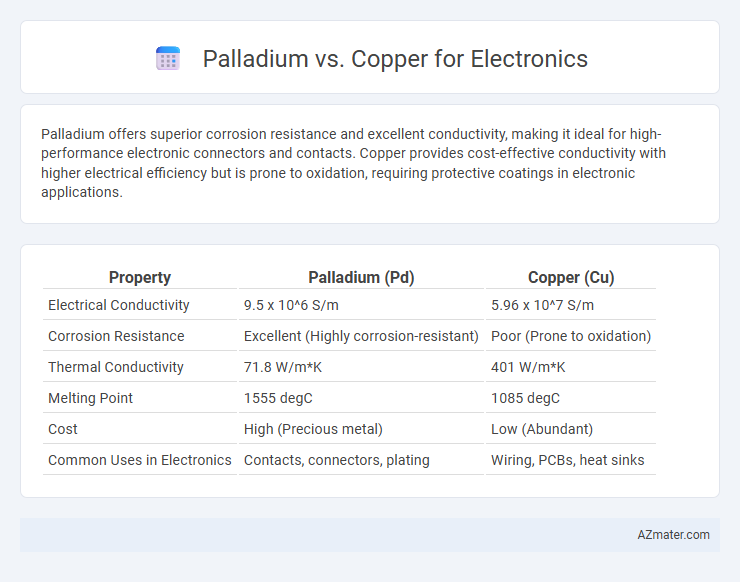Palladium offers superior corrosion resistance and excellent conductivity, making it ideal for high-performance electronic connectors and contacts. Copper provides cost-effective conductivity with higher electrical efficiency but is prone to oxidation, requiring protective coatings in electronic applications.
Table of Comparison
| Property | Palladium (Pd) | Copper (Cu) |
|---|---|---|
| Electrical Conductivity | 9.5 x 10^6 S/m | 5.96 x 10^7 S/m |
| Corrosion Resistance | Excellent (Highly corrosion-resistant) | Poor (Prone to oxidation) |
| Thermal Conductivity | 71.8 W/m*K | 401 W/m*K |
| Melting Point | 1555 degC | 1085 degC |
| Cost | High (Precious metal) | Low (Abundant) |
| Common Uses in Electronics | Contacts, connectors, plating | Wiring, PCBs, heat sinks |
Introduction to Palladium and Copper in Electronics
Palladium and copper are essential metals in electronics, with palladium valued for its exceptional corrosion resistance and excellent conductivity, making it ideal for connectors and multilayer ceramic capacitors. Copper dominates in electrical wiring and printed circuit boards (PCBs) due to its superior electrical conductivity and cost-effectiveness. The strategic selection between palladium and copper hinges on balancing performance requirements, durability, and economic considerations in electronic device manufacturing.
Material Properties: Palladium vs Copper
Palladium offers superior corrosion resistance and excellent electrical conductivity, making it ideal for high-performance electronic components and connectors. Copper boasts exceptional electrical and thermal conductivity with high ductility, which enables efficient current flow and reliable heat dissipation in circuit boards. Both metals provide distinct advantages, with palladium excelling in durability and copper in cost-effectiveness and conductivity for electronics manufacturing.
Conductivity Comparison
Palladium exhibits lower electrical conductivity than copper, with copper's conductivity rated at approximately 5.96 x 10^7 S/m compared to palladium's 9.5 x 10^6 S/m. Despite palladium's reduced conductivity, its excellent resistance to corrosion and oxidation makes it valuable in specific electronic applications like plating connectors and contacts. Copper remains the preferred choice for high-conductivity requirements in wiring and printed circuit boards due to its superior electron mobility and cost-effectiveness.
Corrosion Resistance and Durability
Palladium offers superior corrosion resistance compared to copper, making it ideal for electronic components exposed to harsh environments or moisture. Its excellent durability ensures long-lasting performance in connectors and contacts, minimizing maintenance and replacement costs. Copper, while highly conductive, is more prone to oxidation and corrosion, which can degrade electronic reliability over time.
Cost and Availability Factors
Palladium offers superior corrosion resistance and conductivity compared to copper, but its high cost and limited availability significantly impact electronics manufacturing budgets. Copper remains the preferred choice due to its abundant supply and lower price, enabling widespread use in printed circuit boards and wiring applications. Fluctuations in palladium prices, driven by market demand and supply constraints, often make copper the more economically viable material for mass production.
Solderability and Fabrication Ease
Palladium offers superior solderability compared to copper due to its excellent oxidation resistance, which reduces surface contamination and ensures reliable, strong solder joints. Copper, while more cost-effective, tends to oxidize rapidly, necessitating additional surface treatments to maintain solderability during fabrication. The fabrication ease of palladium is enhanced by its consistent surface quality, whereas copper requires careful handling and protective coatings to prevent oxidation and maintain performance in electronic assemblies.
Applications in Electronic Components
Palladium is widely used in electronic components due to its excellent corrosion resistance, high electrical conductivity, and superior solderability, making it ideal for multilayer ceramic capacitors and connector plating. Copper, known for its exceptional electrical conductivity and cost-effectiveness, is predominantly utilized in printed circuit boards (PCBs), wiring, and integrated circuits. Both metals serve critical roles in electronics, with palladium favored for specialized applications requiring durability and copper for broad, high-volume conductive pathways.
Environmental Impact and Sustainability
Palladium offers superior corrosion resistance and conductivity in electronics, yet its extraction involves higher environmental costs due to energy-intensive mining and scarcity, raising sustainability concerns. Copper, extensively recycled in electronics, presents a more sustainable choice with lower environmental impact and abundant availability, supporting circular economy models in the tech industry. Prioritizing copper reduces resource depletion and greenhouse gas emissions compared to palladium, aligning better with sustainable electronics manufacturing goals.
Industry Preferences and Trends
Palladium is favored in electronics for its excellent corrosion resistance and superior conductivity, making it ideal for high-performance connectors and multilayer ceramic capacitors. Copper remains widely used due to its cost-effectiveness and outstanding electrical conductivity, dominating printed circuit boards and wiring applications. Industry trends indicate a growing preference for palladium in miniaturized and high-reliability components, driven by demand for durable and efficient electronic devices.
Future Outlook: Palladium or Copper?
Palladium's superior conductivity, resistance to corrosion, and catalytic properties position it as a critical material in advanced electronics and automotive applications, particularly for emerging technologies like 5G and electric vehicle components. Copper remains essential due to its cost-effectiveness, exceptional electrical conductivity, and widespread use in traditional wiring and circuit boards, making it indispensable for large-scale electronics manufacturing. Future market demand will likely see palladium gaining prominence in specialized, high-performance electronics, while copper continues to dominate bulk industrial applications with ongoing innovation improving its efficiency.

Infographic: Palladium vs Copper for Electronics
 azmater.com
azmater.com